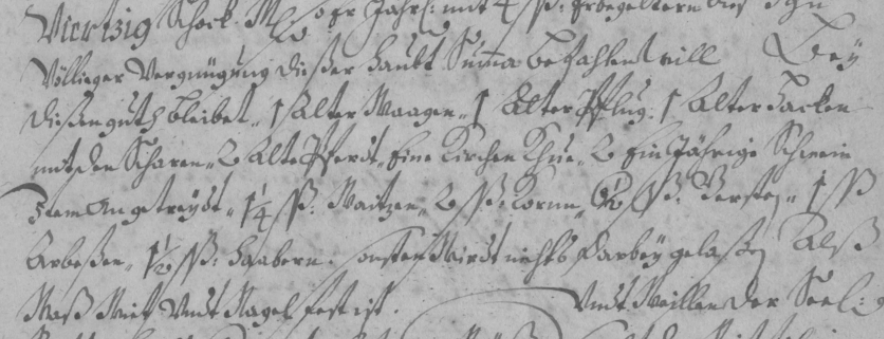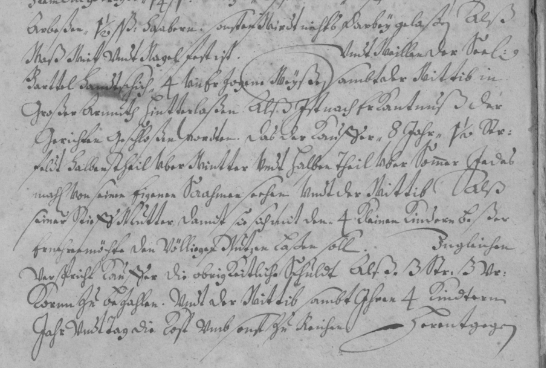Even if the farm possessor in question is not your direct ancestor, it is always worthwhile to peek into a land record of a property of interest. You may still learn interesting facts and add more pieces to the puzzle of your family history.
Recently, I was working on the history of the Handschig family. They were living in the 17th century in the village of Želkovice, in the broader area of the town Louny. I could follow the history of the father Bartoloměj and his daughter Kateřina through two matriky records and in addition to them, I found a record from which I learned that Bartoloměj acquired the farm in 1652.
Kateřina, Bartoloměj’s daughter, was born in 1671. She was the only child I knew from the matriky. Bartoloměj’s wife and Kateřina’s mother was Anna, about whom I had no other detailed information. Bartoloměj could not rejoice for the infant Kateřina for long, because he died three years after her birth. According to his burial record in the matriky, he was 75 years old, which would put his birth to 1599. This meant he would have acquired the farm at the age of 53.
These findings could have closed the research and the chapter about Handschig family, yet it would have been a little premature. I would have lost the information contained in the subsequent property record, which offered more information about Bartoloměj himself than I expected. The above-mentioned record of Bartoloměj’s acquisition is followed (beside the short records of annual payments) by an entry from September 1674 in favour of Bartoloměj’s son Georg. At the beginning of this record written in German, we read that Georg Handschich (sic) from Želkovice takes over a farm with a half lán of fields (in German “Bauern guth alda Nach Einer halben Huben feltes”), which was assessed by the rychtáři (pl.) of Želkovice, Šepetly and Řisuty for 140 kopy groše míšenské. The purchase price was to be paid with 4 kopy groše a year. Nothing special so far, yet the record goes on to list the things that were to remain with the farm.
It lists what remained on the farm with the purchase: “an old wagon, an old plough, old harrows with spikes, 2 old horses, one church cow, 2 one-year-old sows, wheat worth 1¼ ß, rye worth 2 ß, barley worth 6½ ß, peas worth 1 ß, oats worth 1½ ßs, otherwise nothing has been left here that is not fixed with a rivet or nail.

To help you practise working with the Czech text, in addition to the translation, I also provide a transcription of the original language and a „translation“ into „more standard“ German.
German 1: […] Bey | dießen Guth bleibet 1 alter Waagen, 1 alter Pflug, 1 alter Hacken | mit den Scharen, 2 alte Pferdt. Eine Kirchen Khue, 2 EinJährige Schwein, | item an Getreydt 1¼ ß Waitzen, 2 ß Kornn, 6½ ß Gersten, 1 ß | Arbessen, 1½ ß haabern, sonsten wirdt nichts dabey gelasen als | Waß Neit und Nagel fest ist.
German 2: […] Bei diesem Gut bleibt 1 alter Waagen, 1 alter Pflug, 1 alter Hacken | mit den Scharen, 2 alte Pferd. Eine Kirchenkuh, 2 einjährige Schwein, | item an Getreide 1¼ ß Waitzen, 2 ß Korn, 6½ ß Gersten, 1 ß | Erbsen, 1½ ß Habern, sonsten wird nicht dabei gelassen als | was Neit und Nagel fest ist.
At first glance, it is a normal list of what we would find on any farm. However, notice how often the adjective „old“ appears in the description. We see an old wagon, old harrows, an old plough, and even old horses. One might think that Bartholomew’s management was not very good when he had to be content with old tools and equipment. In addition, on the farm we find a church cow (Ger. Kirchenkuh), which was a cow that belonged to the church’s fabrica ecclesiae and which was leased to farmers for an annual payment; basically such an operating lease of the 17th century (more about the church cow in Chapter XV-3-ii). Bartholoměj could not afford to get his own cow that would belong to him. So we see before us the image of a farm that is held together only by its very nature, the farmer only maintains what he has and fails to ensure a sufficient standard of living that he could have obtained from a half-lán farm. But what can we expect from a man over seventy?
That the previous description is not only a modern projection, is also proven by the next paragraph of the record.

German 1: Undt Waillen der Seel. | Barttl Handtschich 4 unerzogene Weyßen sambt der Wittib in | großen Armuth hintterlaßen als ist nach Erkantnuß der | Gerichten geschloßen wordten das der Kaufer 8 Jahr 1½ str | feldt halbentheil uber Wintter und halben Theil uber Sommer jedes | mahl von seinen eigene Saahmen seehen und der Wittib alß | seiner StiefMutter damit sie sich mit den 4 kleinen kindern beßer | Ernahen möchte den völligen Nutzen lassen soll. | Ingleichen verspricht Kauffer die obrigkeitliche Schuldt als 3 str 3 w | Korn zu bezahlen undt der Wittib sambt Ihren 4 Kindern | Jahr und tag Kost umb sonst zu Reichen(?). herentgegen | [fol. 194pv] Bewilliget sie Ihm nach möglichkeit In dießen Jahr) an die handt zu gehen und seine Nahrung führen zu helfen.
or in a bit more modern German wording
German 2: Und weil der seel[ige] | Barttl Handtschich 4 unerzogenen Waisen samt der Wittib in | großen Armut hinterlassen als ist nach Erkanntniss der | Gerichten geschlossen worden dass der Käufer 8 Jahr 1½ | str[ychen] Feld halben Teil über Winter und halben Teil über Sommer jedesmal | von seinen eigene Saahmen seehen und der Wittib als | seiner Stiefmutter damit sie sich mit den 4 kleinen Kindern besser | ernähren möchte den völligen Nutzen lassen soll. | In gleichen verspricht Käufer die obrigkeitliche Schuld als 3 str[ychen] 3 v[iertl] | Korn zu bezahlen und der Wittib samt ihren 4 Kindern | Jahr und Tag Kost umsonst zu Reichen(?). herentgegen | [fol. 194pv] Bewilligt sie ihm nach Möglichkeit in diesem Jahr) an die Hand zu gehen und seine Nahrung führen zu helfen.
which translates to:
„And because Bartl Handtshich left 4 ungrown orphans together with a widow in great poverty, it was decided by the rychtáři that the buyer will sow 1½ strych of the fields with his own seed for 8 years, halfway in winter and halfway in summer and leaves [the fields] to the widow as his stepmother to take 4 small children for [their] full use [so that they] could feed better. At the same time the buyer promises to repay the debt of 3 strychy 3 věrtele of rye and to give food to the widow with 4 small children for one year and a day. On the other hand, the widow agrees that, if possible, she will do his biddings this year and she will [also] contribute to get them food.“
As you can see, Bartoloměj really didn’t do well. In addition to owing the landlord about eight sacks of rye, he left a widow and four small children in great poverty. We also learn that Bartholomew was married at least twice, a fact which is not ascertainable from matriky records. His son Georg from his first marriage inherited the farm while Anna, whom we already know as Kateřina’s mother, was his second wife and later a widow. Another very interesting aspect of the record is how the poor widow and four orphans were cared for. While valuing the property, the rychtáři decided that the new farmer would provide his stepmother and her children (i.e. his half-siblings) for eight years with the yield from fields with an area of one and a half strych and he had even to use his own seed. However, you may note that the obligation does not apply to the provision of housing. It was only the food provision to a family which lost the breadwinner.
We do not know what played a role in the decision-making of rychtáři, but situations where between the heirs there were children from the first marriage and a widow and children from the second marriage rarely had an easy and quiet solution.
Glossary
This is a very brief explanation of some terms used in this post. Each is followed by a reference to a section in The Researcher’s Guide to the Czech Land Books which provides a deeper and detailed explanation.
- Rychtář was representative of the estate administration as well as representative of the village. See Chapter VII-2-iii.
- Kirchenkuh (Ger.) or kostelní kráva was kind of an operating lease of the 17th century. See Chapter XVI-3-ii or here.
- Lán was used as a basic parameter to express the size of the farm. See Chapter V-2-ii.
- Strych is an old field measure unit. See Chapter XII-4-i.
- Fabrica ecclesiae was a special property designated for the support of church operations. See Chapter I-2-ii.